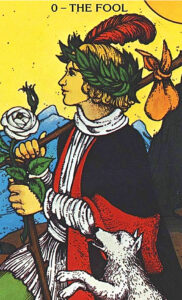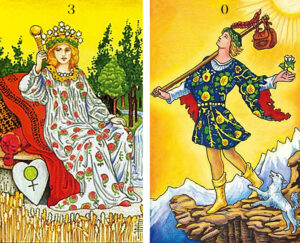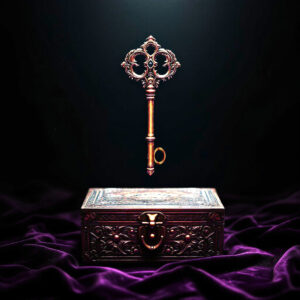Bupkis and The Beggar
by Penny O | July 1, 2025

Nothing. Naught. Nil.
Diddly. Goose-egg. Bupkis.
Zilch. Zip. Zero.
No matter how you say it, the number zero is more than just… nothing. As a number it’s a compelling concept that revolutionized mathematics and science. And in its contradictory nature, zero has played a unique part in the enrichment and elevation of philosophy and esoteric wisdom, allowing for deeper understanding of what is, while compelling us to consider what isn’t.
Zero, in spite of being the lowest of numbers, nobly wields the power to express the inconceivable for it is that which permits the representation of the greatest of numbers. And yet this number, while providing the means and structure for the discovery and abstraction of mind boggling quantities, is itself an absence of quantity.
In its evolutionary journey through the mathematical systems of the ages, (Babylonian, Mesoamerican, Greek, Egyptian, Indian, and ultimately the Arabic and European), the number zero was as transformational as it was practical. Before the discovery and adoption of the zero, or its invention depending on the school of thought, numbers had to be expressed using uniquely different symbols, making notation and delineation cumbersome and awkward.
Without the ability to increase their magnitude, numbers couldn’t fully evolve, as placing a zero after any number not only increases the number’s quantity, it evolves its quality, thereby transforming its identity and significance. When following other numbers, zero becomes a placeholder that represents the power of ten—the number one effortlessly becomes the number ten, the ten becomes one-hundred, and one-hundred triumphantly becomes one trillion.
It’s been estimated that a human could conceivably count to one billion in their lifetime, taking about thirty-two years to do so. But what about a trillion? Adding just three more zeros pushes the count time to thirty-two thousand years. The addition of this most elementary of symbols, in essence a circle, to any number not only reveals the number’s potential or progression, it also serves as a waymark and threshold to the potential and progression of our own imagination and innovation.
The number zero has another equally important purpose beyond increasing the quantity and quality of any number it follows. When a zero is within the bounds of a number, it acts as a placeholder that signifies the absence of value. For example, in the number 307, zero indicates an absence of tens, distinguishing the number 307 from the number 37.
It could be said then, that the zero allows for an assertion of uniqueness simply by expressing nothingness.
And whether zero was invented or discovered, or some serendipitous amalgamation of both, it is perhaps in the number’s development, application and propagation thereof, that our first ideas about not just nothingness, but the nothingness, were first conceptualized. And as we continue to further theorize on, and give definition to, the nothingness or the undividedness of Being, we construct more complex and meaningful symbols—which in turn help us navigate our relationship to it.

The word zero comes from the Arabic sifr, meaning “nothing, empty, or vacant”. Sifr is also the source of the word zephyr, the west wind, or “moving of air”, and more specifically refers to “that which is lighter than air”. This Arabic word is also the source of the word cipher—the encryption and decryption of messages and the process of converting data into a code. And as each cipher functions in relationship to a key, or means of deciphering code, this is where we arrive at the first of the Major Arcana cards—Key 0 The Fool.
The word “fool” stems from the Latin follis, meaning “a bellows, or a container of air”. Key 0, corresponding to Air as one of the three prime elements, also refers to the Ruach, the divine breath or “life-breath”, the movement of spirit, and the infusion of spirit into awareness and manifestation.
The Fool, like zero, is also a contradiction of sorts. Key 0 is the “lowest” of the numbered cards and as pure potential before actualization it is that with the least differentiated or subjective experience. And yet, as the living presence within both the potential and the actualization, it is the force that moves through each card and is itself transformed by experience. This seeming contradiction is mirrored in the dynamics of Key 21 The World—typically, the highest of the numbered cards of the Major Arcana. The World is a representation of actualization, accomplishment and attainment of cosmic consciousness within the boundary of eternal potential and the indivisible consciousness—seen as the living green wreath of a zero which encompasses the figure in many illustrations. In some depictions, this same green wreath is seen around the head of The Fool as a symbol of the superconsciousness that crowns and accompanies the figure throughout the journey.
Perhaps it is in the relationship to follis, the bellows, that the action and influence of The Fool in relationship to consciousness is revealed. It may be that this Key is the bellows applying the influence of spirit (air), upon impetus or will (fire) to keep it ever burning. The Fool, with unflappable resolution and looking ever skyward and forward, moves through life as though always starting fresh, and not deterred by past experience—or, as if starting from zero.
Typically when used, the phrase “starting from zero”, or “going back to zero”, imply a start from a place of disadvantage, or the return to a starting point after a setback or perceived failure, as though nothing were gained. Here, in The Fool, going back to, or starting from, zero may be given fresh meaning—back to a point of optimism, back to a state of hope, openness, or humility, and being given the opportunity to restart from a place of confidence and unmarked possibility. As zero, The Fool has the ability to move through life with naive abandon, as if every attempt was the first attempt, and redemption and the chance for a do-over is always within reach.

As an alternate name for The Fool, The Beggar is a title that was more often in use earlier in the card’s history, with symbolic representation for it not often seen today. The genesis of beggar is said to come from the French Beghards, a mendicant order of monks or lay-brothers who took on vows of poverty and endeavored to help those in need. The name evolved into the word begart (circa 1200) and referred specifically to “one who asks for alms”, or charitable relief for the poor.
Perhaps it could be imagined, then, that our modern day (post 1900) depictions and embodiments of the card as we have come to know them, suggest a Fool who has accumulated their carried possessions not only through lived experience or cultivation, but also through the act, or art, of “begging”—or, in the manner the word was used at its origin, by humbly asking.
And might simply asking for what one needs, knowing the request might very well be denied, be a living example of certain imports of this card? Are these then the true gifts The Beggar might have humbly asked for on the onset of their journey— acting on a leap of faith, opening oneself to potential and opportunity, walking tall with optimism and hopefulness, or possessing the qualities of naivete and the “foolhardy” belief that maybe everything will come out OK—even after stepping off that cliff into the unknown?
And what might we, as The Fool on our own journey, also ask for, given we possess the humility and ability to make the request in the first place? What might we take a chance on, if we thought that maybe… just maybe… there was indeed the possibility we might truly receive what’s needed?
PUTTING IT INTO PRACTICE
Consider the practical or methodical relationship between The Fool and the rest of the cards. When we view The Fool through the lens of zero, a few basic ideas stand out that may serve as jumping off points:
1. As zero evolves the quantity and quality of any number it follows, The Fool may also be seen to increase or evolve the qualities of the cards, given that it is emblematic of the animating presence inherently running through each.
As a simple example, let’s say there’s a creative block being experienced and The Empress card is employed in meditation as a means to tap into one’s imagination and flow. The qualities of The Empress—creativity, imagination, fruitfulness, abundance, feminine and maternal energy, connection to the rich bounty of nature, skill in the arts, productivity and growth— could be enhanced when considering them through the lens of Key 0—optimism, spontaneity, a willingness to take chances or risks, being open to the unexpected, leaning on intuition, and the willingness to take steps into the unknown.

2. Like the “bag of wind” or bellows, The Fool card may serve as that which unfailingly stokes the fire of will and sustains momentum through the transformative journey of the Tarot.
Again, using the example of The Fool with The Empress, a mantra could be created by using keywords of each which remind one of the power and flow of personal creativity when used daily or at specific opportune times. Something like: I increase the flow of my creative power by remaining ever open to possibilities. Or, I am willing to take creative risks regardless of past experience or outcomes. These are basic examples, but the possibilities to make the mantra personally relevant are endless.
3. Like the zero in its role as a placeholder of the absence of value (307 and not 37), The Fool, as a state of potential before actualization, imposes no concrete definition or assumptions or expectations based on prior experience. Therefore, The Fool in combination with another card—whether in meditation, divination or as part of magical practice—may act as that which highlights the properties of a card that might be blocked or rigid.
As part of meditation, working with Fool energy for a period before focusing on the other Key can be beneficial. Simply getting in touch with the spontaneous, hopeful and open to possibility parts of our nature before doing work with another card can trigger an inner conversation that reveals where, or why, alignment with those qualities—in this case Key 3 and creativity or use of imaginations—is frozen, obstructed or lacking. “Starting from zero” here is perhaps an apt approach to the creative gifts of Key 3 as it allows us to consider these gifts anew, with fresh eyes.
4. The Tarot may be considered as a “secret” code, (as the arcana or arcanum), or The Fool specifically as a cipher, (the root sifr); a card in relationship to any other can serve as a key to more deeply deciphering the significance and import of the properties of each.
Incorporating some of the symbolic correspondences of the Keys into your physical space may be worth exploring. When trying to tap into creativity—writing, music, drawing, sewing, crafting, design, etc—hanging a perfumed sachet in the space or around the neck or crafting an oil to diffuse, made from the elements of The Fool and Empress in this case—rose, coriander or apple (The Empress) with galbanum, linden or peppermint (The Fool)—might serve as a stimulating and inspirational background element.
Making emblems or totems out of photos, figurines or drawn sigils of a rabbit or dove (The Empress) with a butterfly or crocodile (The Fool) might also be useful in connecting to the abundance of ideas. The addition of an amulet worn around the neck of copper or emerald (The Empress) in combination with topaz or clear quartz (The Fool) may also serve as an effective catalyst. The idea is basically adding the elements of The Fool to whichever energy you are working with could act as that zero, enhancing and evolving the card number’s potential— as in 1 becomes 10.
5. And lastly, but certainly not least, as The Beggar, the Fool may suggest a practice of just asking for what’s needed.
In this example, as The Fool petitioning to the virtues of Key 3 The Empress, asking for assistance, simply and humbly, and in faith, and to who or what, and in the manner that most speaks to you, may prove to be unexpectedly insightful, beneficial, and grounding.
In closing, this quote by author Thomas Stark from his 2018 book God is Mathematics, might speak further to the beauty and power of zero, and The Fool.
Zero is not a point of non-existence. Zero is always a balance point of existents. The human understanding of “zero” must undergo the most radical of all transformations. Most people, especially scientists, associate it with absolute nothingness, with non-existence. This is absolutely untrue…

COMING SOON
Part 2 of Zero and The Fool, How Zero Pertains to One
UPCOMING EVENTS
The OHM Conclave in Santa Fe: Death, Transformation and Immortality
Information on fall OHM Zoom classes coming soon
